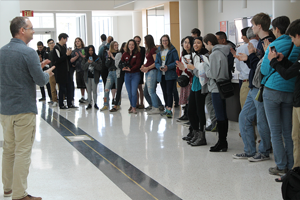Fall Equinox to Arrive with Movement of Sun
A carefully designed but ancient feature of Austin College’s IDEA Center will be “in action” Monday, September 23, as the precise arrival of the Fall Equinox is marked. The IDEA Center itself serves as a large astronomical observatory that displays the movement of the Sun through the gnomon hole in the roof across the building’s Oscar C. Page Atrium to mark the winter and summer solstices and the vernal and autumnal equinoxes along a meridian line built into the floor.

The public is invited to join the gathering of students and faculty from 1 to 1:25 p.m. to watch the progress of the Sun as it casts an image on the atrium floor and aligns with the equinox marker at exactly “solar noon,” (1:18 p.m. CDT). The IDEA Center is located on the Austin College campus at 1108 E. Richards Street in Sherman. The event is free and open to the public, weather and sunlight permitting. Sunlight is required for the event.
The annual fall and spring equinoxes are the two days when the sun shines directly on the equator and provides nearly equal daylight and night hours. A gnomon hole is an ancient device originally used to compute time.
Dr. David Baker, professor of physics, director of the Adams Observatory, and author of the award-winning book The 50 Most Extreme Places in the Solar System, will provide comments and instruction during the event.
“Watching the sunbeam march across the floor of the Page Atrium and arrive at the equinox marker is magical,” said Baker. “It marks a significant moment in time, one that has been observed by many civilizations throughout history. The solar observatory at Austin College does it in a special way. It’s worth seeing.”
The atrium was constructed so that the sunbeams of the fall and spring equinoxes fall on the Chinese symbol for the Sun in recognition of Asian contributions to knowledge of the universe. The summer solstice is marked by the Greek/Macedonian symbol for the Sun to symbolize the contributions of the West in the understanding of the universe, and the winter solstice is marked by the Mayan symbol to recognize Native American contributions.
Austin College, a private national liberal arts college located north of Dallas in Sherman, Texas, has earned a reputation for excellence in academic preparation, international study, pre-professional foundations, leadership development, committed faculty, and hands-on, adventurous learning opportunities. One of 40 schools profiled in Loren Pope’s influential book Colleges That Change Lives, Austin College boasts a welcoming community that embraces diversity and individuality, with more than 50 percent of students identifying as persons of color. The residential student body of approximately 1,300 students and more than 100 expert faculty members allow a 13:1 student-faculty ratio and personalized attention. This year, the campus recognizes 100 years of co-education and has had several opportunities to recognize the history of women and accomplishments of current alumnae. Austin College is related by covenant to the Presbyterian Church (USA) and cultivates an inclusive atmosphere that supports students’ faith journeys regardless of religious tradition. Founded in 1849, the College is the oldest institution of higher education in Texas operating under original name and charter.
